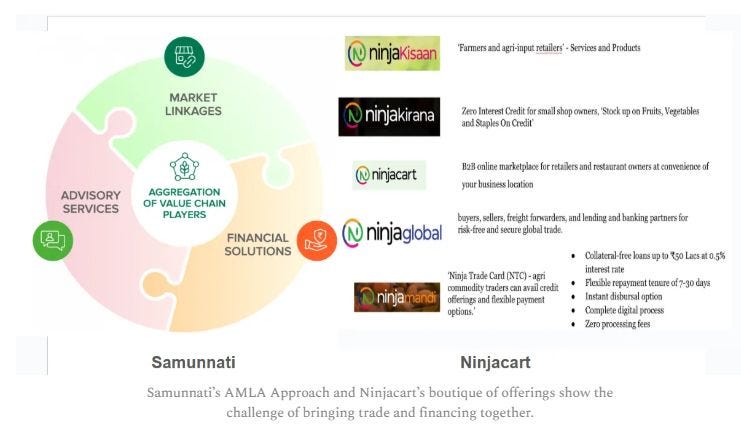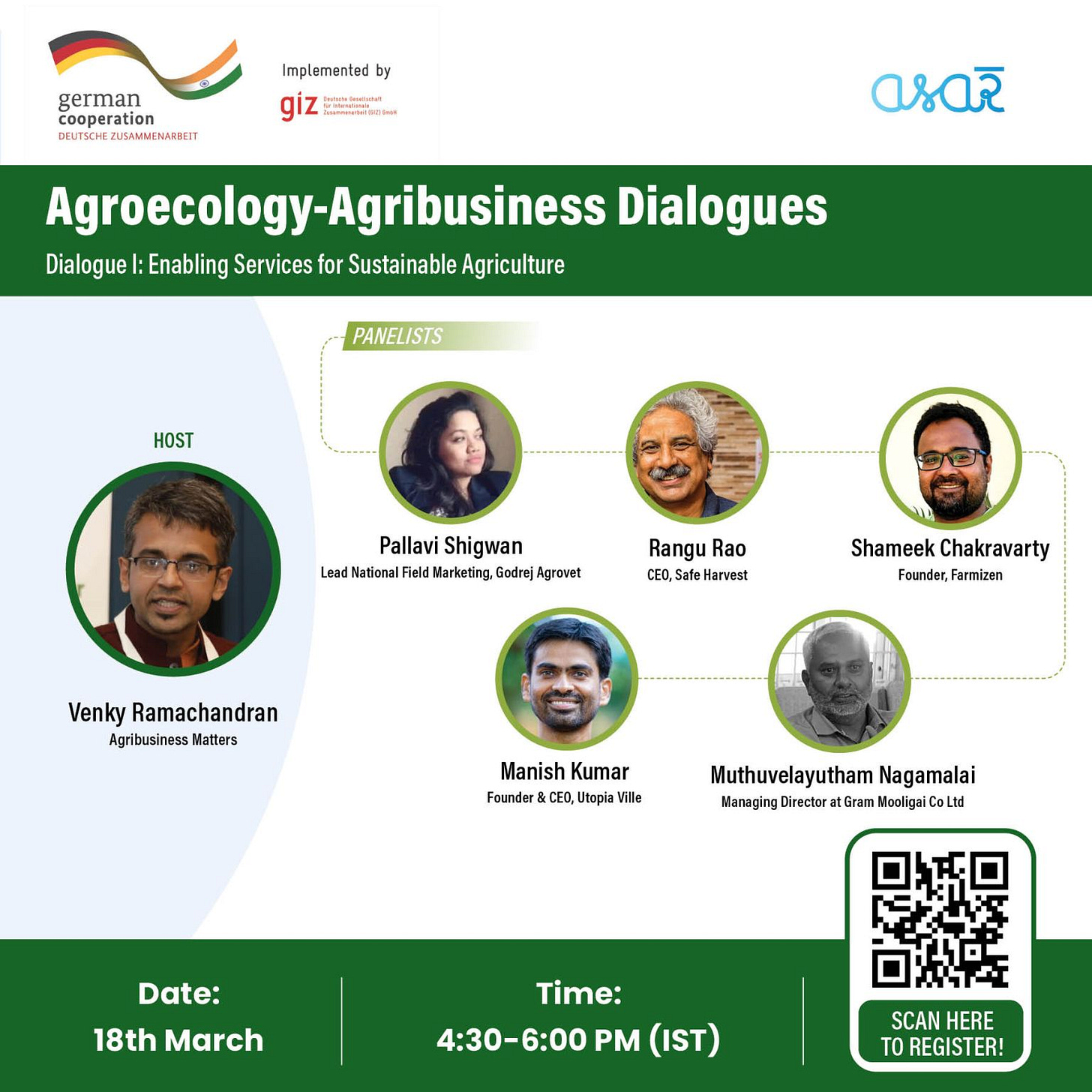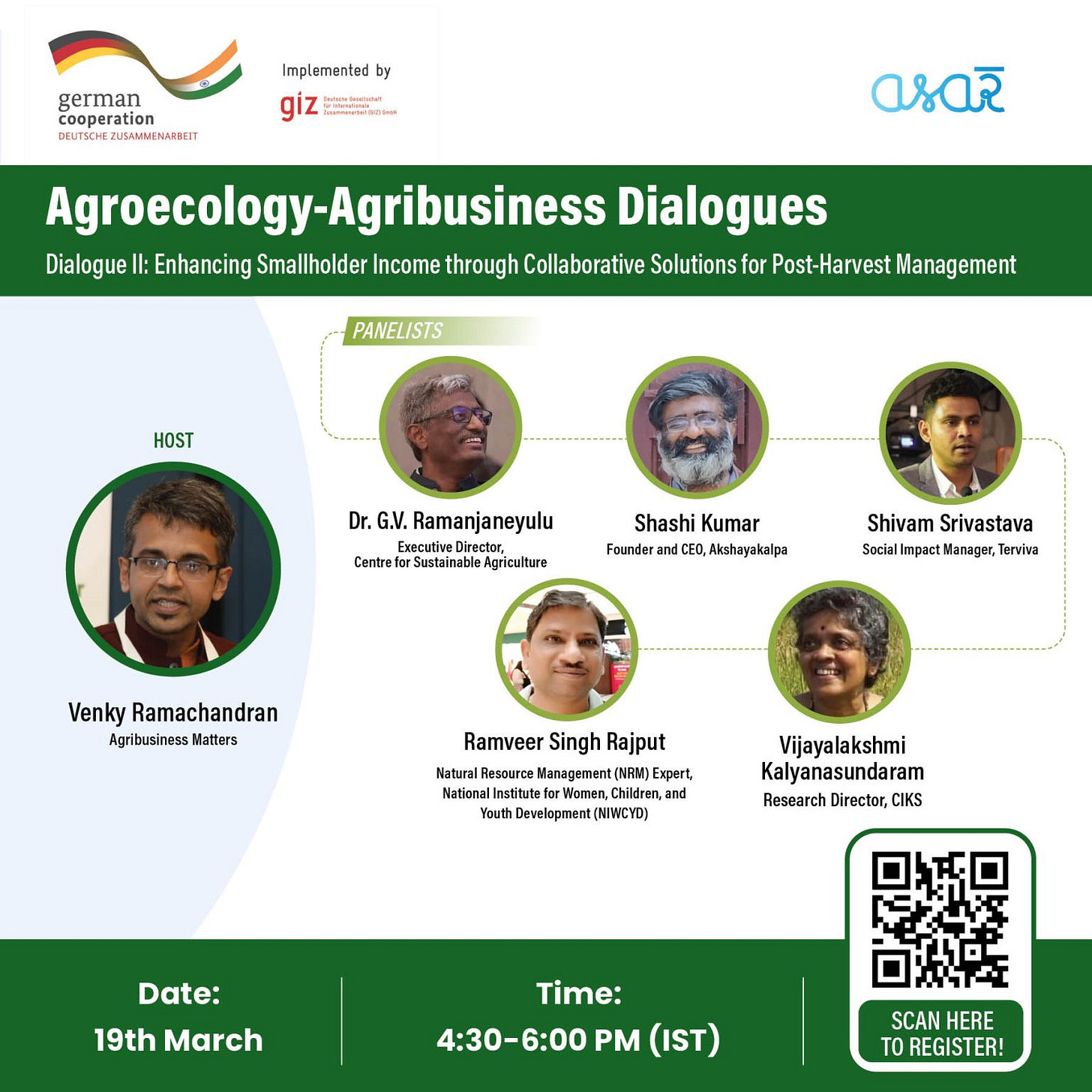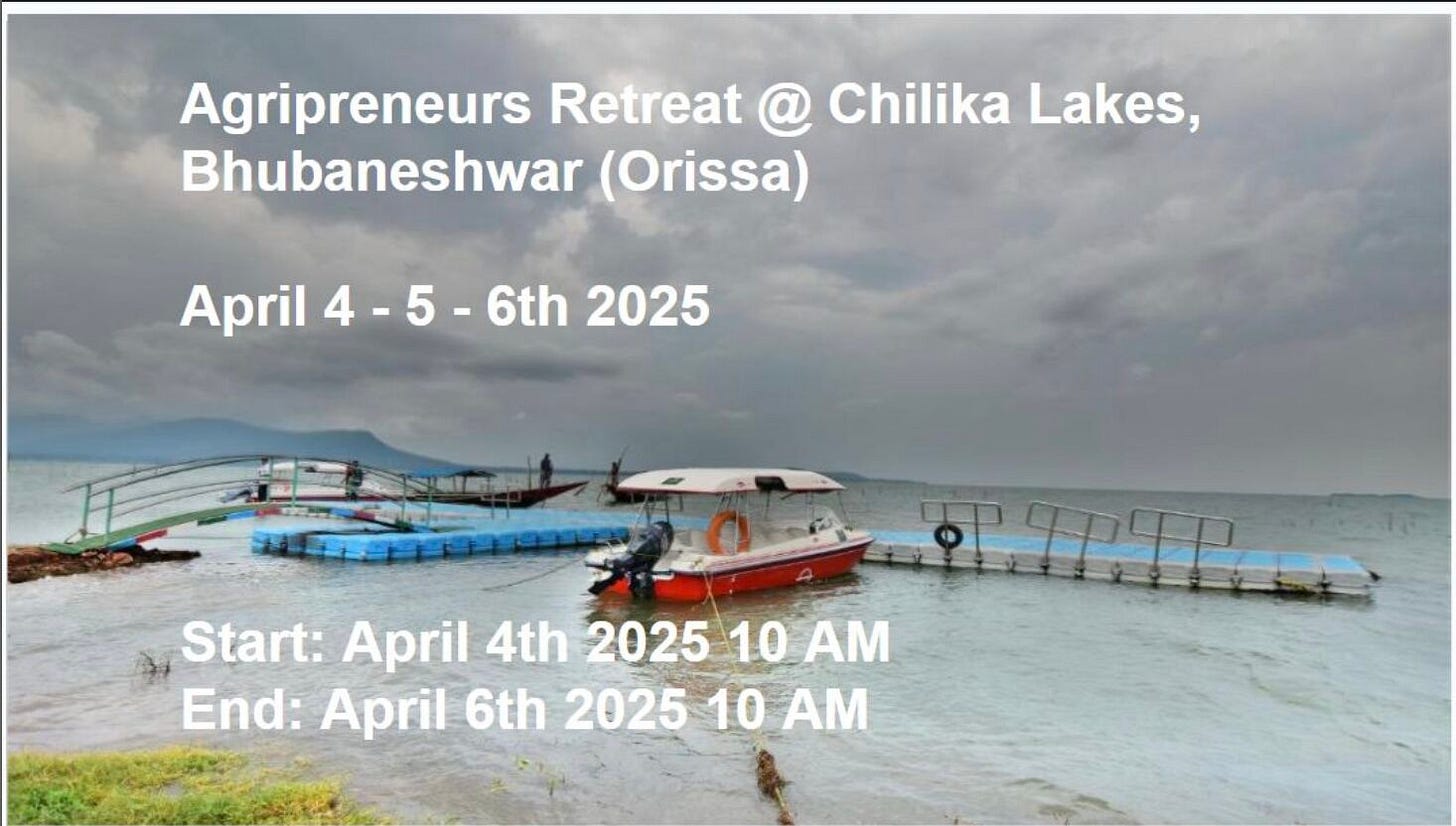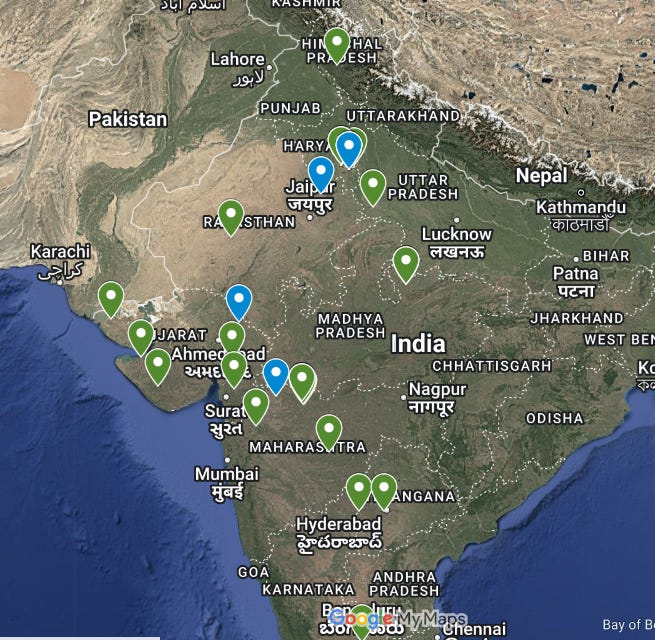
Dear Friends,
Greetings from Hyderabad, India. Welcome to Sunday Reflections where I reflect on what I’ve written and ask myself, In doing what I am doing, what am I really doing?
Subscriber-Only Post Plugins
Agritech Chinese Walls($)
Can an agritech venture operate as both an NBFC and a trader?
Should we build a Chinese wall between NBFCs and Trading businesses, similar to the one between buy-side and sell-side firms, between impact consulting and on-ground implementation businesses?
Historically, traders have managed credit risk within supply chains by leveraging relationships and assessing buyer credibility. However, when financial service providers attempt to take on trading roles, they introduce competitive conflicts that hinder the adoption of their financial products.
This is similar to Amazon Retail India's current practices. The company leverages vast data on seller performance to promote its private label, Vedaka, thereby undercutting suppliers.
What Chinese firewalls can be created to avoid these trust deficits?
Ex-Post Facto:
In response to my article, Biswajit and I had an interesting dialogue:
Biswajit: “Companies that are doing both (trading and lending) are being vilified. I can't understand why. The margins are super low any which direction you go in this domain. if some have been able to figure out the market and financing well enough, I don't see a reason why they should not engage in both. They are just protecting their turf and from whom, the same middlemen who have been the bane of the industry. And at the end of the day, accounting for all the costs, what the companies get doesn't break even. If we want to see good and big companies to emerge from this space, unnecessary regulations got to stop.”
Venky: The question is of trust. You lose trust when you are stealing clients through patterns you've discovered.
Biswajit: I am tempted to agree with you as that would probably serve my present state. But if the market-determined rates are being agreed on, I would rather have this arrangement to work out. The beneficiary should always have the choice of course.
More on Agritech Chinese Firewalls in a recent subscriber-only edition of Agribusiness Matters
State of Agri-Fintech 2025($)
Few days ago, I published my data-driven commentary and the complete “State of Agrifintech” panel dialogue for the members of the ABM Community. Here is a small excerpt: If the panel were to make a presentation to India’s Finance Minister, what would be their top 3 recommendations for policy-level changes? Presenting Ragavan’s (CEO, DGV) and Emmanuel’s (Investment Director, Caspian) pointers.
A Double-Edged Sword Called Subsidies
If you want a live-case study of why agritech is a wicked problem, try and study the role of subsidies in smallholding agritech.

In the world of smallholding agritech, many technologies (solar pumps, solar dryers, controlled-environment agricultural technologies, irrigation technologies) are massively subsidized by private and public capital stack sources. What could go wrong? The thread I facilitated led to many interesting discussions.
In theory, subsidies are part of the game. As Manoj (whose Social Alpha funds and subsidizes many smallholding agricultural technologies) put it, ‘Without subsidies many (agri)businesses won’t take off. Some will perpetually be subsidised. Some will find equilibrium’.
So what are the unintended consequences?
As
neatly put it, it leads to 1) Misaligned incentives - Farmers wait for the subsidy transfer to happen instead of buying the technology 2) Long Reimbursement Cycles - Creating Cash flow problems (as farmers pay upfront and wait for subsidy transfers) 3) Misalignment between technology’s original purpose (crop productivity) and subsidized purpose (saving water)And then there is sub-system misalignment, as Sudhanshu puts it: “In the case of a Drip irrigation system ,to avail subsidy you need to procure only the IS standard drip system, The subsidy is say 60% However to avail it, you need to spend @Rs 55,000/- per acre for IS grade drip system, whereas for non IS it costs Rs 28,000/- per acre ”.
At the end of the day, as Amlan beautifully put it, “Some businesses or initiatives may need initial support but breastfeeding an adult is simply ridiculous.”
In smallholding countries like India, where public infrastructure spending is abysmal, there is a strong logic behind subsidies that eventually increase private gross capital formation in agriculture.
The trouble lies in its unintended consequences. Can Digital Public Infrastructure and DBTs (Direct Benefit Transfers) make them efficient and transparent?
Is Biochar Overrated?
Few weeks ago, I wrote a post called “Biochar is Overrated”. In retrospect, the choice of the title’s phrasing was an impulsive click-bait decision. In all honesty, I should have titled my essay, “Is Biochar Overrated?”
My clickbaity instincts nevertheless led to interesting ripostes from readers and Biochar enthusiasts. Tejas wrote a fascinating comment that made me re-examine my priors of Biochar as new-age technologies
“We have progressively used lesser charcoal in villages and agriculture around the same time we progressively used more chemical based inputs in agriculture. Rough calculations by AI suggests that we produced 10–12 million tons of charcoal per year from household woodstove cooking in 1965. Most of this went to the farm yard compost and then into our soils. https://chatgpt.com/share/67ac74e0-6b14-8005-8723-09aed0892d46 Biochar is a old subject packaged under a new name. Villages lost it as we transitioned to cleaner and safer cooking energy.”
EVS Prakasa Rao contextualized Biochar in today’s soil conditions.
“large majority of Indian soils are deficient in phosphorus. With no rock phosphate reserves, India will have a severe shortage of P fertilizers by 2050. Any technology that enhances P efficiency in soils and crops will play an important role.”
Few moons ago, I attended a Biochar Manufacturing workshop where I got to meet several players in this space. What I picked up is largely this concern: Unless we regulate the feedstock quality, we are not going to get the best results. As my friend Tejas neatly puts it, Biochar is an "Empty Revolver".
Tejas provided the right nuance around my understanding of Biochar as an empty revolver.
“Coming to the ‘empty revolver’, it is a great container that can carry with it a whole lot of good into the soil. It fits perfectly well with the regenerative farming methodology and can help in many ways. In the age of immediate returns, this property of an empty revolver in its raw form needs to be well understood, and careful charging of Biochar with soil and plant-friendly components is paramount. It can be a silver bullet, but only when used well. Else it could also hurt in the short term”
Can biochar deliver its promises of the ‘best delivering CDR methodology’ in India?
Upcoming Events: Agroecology Agribusiness Dialogues (Online) facilitated by yours truly
Agroecology and Agribusiness have largely been unfriendly with each other. The former hates the latter for pushing soil health as a tertiary problem while the latter hates the former for subsisting on doles, nonprofits without a clear demand curve. Can the two get back to talking terms? How do we facilitate this partnership?
I am excited to dialogue with some of the finest professionals working in agroecology contexts on the 18th and 19th. You can join the conversation through the registration link below.
📅 Date: 18-19th March
⏰ Time: 4:30-6:00 PM (IST)
🔗 Register now: RSVP Link
Upcoming Events: Fourth Edition of Agripreneurs Retreat (In-Person)
After the success of the three Agri-founders' retreats in West - Nashik(Jan 2024), South -Bangalore (May 2024) and North -Jaipur (Aug 2024), we are hosting our fourth retreat for 50 Agripreneurs/Agritech founders on April 4-5-6 in Chilika Lake, 115 km from Bhubaneshwar Airport.
It's one of the most beautiful lakes I’ve been to, with amazing freshwater Irrawaddy dolphins that happily go around.
The eastern part of the country has been the neglected child, starting from the Green Revolution days. We want to invite 50 Agripreneurs from Kolkata, Bhubaneshwar and NorthEast and others from other parts of India to make it an incredible learning experience for the community and from the community to dream of a better future for Indian agriculture.
Agripreneurs who wish to register can do so here. If you would like to collaborate for the event, do reach out.
Indian Ag’s Agriphoto-voltaic Wave
India’s APV (Agri-Photo Voltaic) Wave is picking up at a time when the US Govt is attempting to pass “No Solar Panel On Fertile Farmland".
In June 2023, Representative Mary Miller of Illinois introduced the "No Solar Panels on Fertile Farmland Act of 2023" (H.R.4257) in the 118th Congress. This bill aimed to amend the Internal Revenue Code to exclude properties and facilities located on prime farmland from certain renewable energy tax credits.
In Oregon, agrivoltaic developments—where solar energy production is combined with agriculture—are permitted on up to 20 acres of farmland. Santa Clara County, California, prohibits commercial solar farms on land zoned for large-scale agricultural uses.India has made significant progress in solar energy adoption, with total installed solar capacity reaching 92.1 GW as of October 2024. Whenever newer agricultural technology emerges, you can expect Ashok Gulati to be giddish about its potential and this ICRIER report evangelizing APVs is no different.
The report argues that APV, which combines solar energy generation with agricultural production, could help maximize land use efficiency, boost farmer incomes, and support India's clean energy goals.
The authors examine global case studies and technological innovations in APV to draw lessons for India.
Key challenges include high capital costs, inadequate infrastructure, land conversion issues, and lack of stakeholder coordination. The report analyzes different business models and economic scenarios for APV implementation, finding that it becomes economically viable at tariffs similar to the PM-KUSUM Component.
“ Our analysis finds APV to be economically feasible for developers with payback periods ranging from 13 years (at a tariff of 3.25 INR/kWh) to as low as 9 years (at a tariff of 4.56 INR/kWh), where tariff of the PMKUSUM Component A in Rajasthan that has the highest installation under the scheme is found to be 3.25 Rs/kWh and the Average Power Purchase Cost (APPC) of thermal power in India “
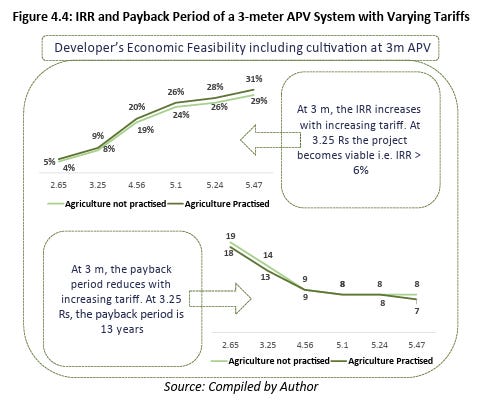
The report throws open a few questions. What are the unintended second-order consequences?
Would APV impact or be impacted by water availability for agriculture?
Would APV force farmers to change their farming practices? How could a farmer understand the trade-offs?
While APV offers environmental benefits, what are the long-term effects of large-scale solar installations on soil health and local ecosystems?
How do we compare APV with other renewable energy sources used on the farm?
On Abundance:
There is nothing more joyous than bumping accidentally into readers of my newsletter in strange places and hearing directly their unfiltered, raw perceptions and feelings they are evoked through the art of reading.
It's fascinating to watch the magic that unfolds when strangers become friends simply through a few invisible connections that are hard to put into words.
Few moons ago, I met a stranger accidentally at the Indian Agricultural Research Institute. I will never forget what he said. "I thought you must be a wealthy person for doing what you do at Agribusiness Matters and I was worried if you would stop it sometime"
In many ways, running the Agribusiness Matters newsletter besides organizing not-for-profit Agripreneur retreats and building a community of agripreneurs with no profit motives have largely been possible, thanks to the universe showering me with abundance and wealth of various kinds in unimaginable ways
In a half-colonized country like India where earlier markers of status and respect are declining and material wealth becomes a surrogate for one's status, poverty and material poverty are often deeply confused and it has taken me many years to understand the difference between the two.
You could be materially poor and still live wealthy like a king. You could be materially abundant (with a high net worth) and live like a poor man.
People do entrepreneurship for various reasons.
Some want to go after "boring businesses" and make it large on the Forbes list. Some want to scratch their technological itch and chase moonshot problems. Some have bigger ambitions.
What about me? Entrepreneurship is an intimate adventure of self-discovery and living a well-rounded life.
I know I am passionate about food and agriculture. But I don't know what I will do in this space ten years from now. I have many ideas. I want to try doing new things that will help me understand myself and agriculture better.
Unlike other professions, farming doesn't create a demarcation between life and livelihood. And that's the benchmark I set. Can I discover what it takes to live a life that is as abundant as the fundamental design of agriculture?
One thing is certain: I will keep documenting my learnings in my newsletter!
So, what do you think?
How happy are you with today’s edition? I would love to get your candid feedback. Your feedback will be anonymous. Two questions. 1 Minute. Thanks.🙏
💗 If you like “Agribusiness Matters”, please click on Like at the bottom and share it with your friend.


